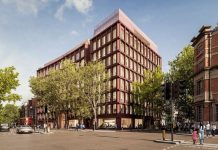Companies leased a record 3.7m sq ft of additional Central London office space in 2017, as expanding firms opted for additional ‘top up’ space rather than full scale relocations, according to the latest research from Cushman & Wakefield.
The latest Movers & Shakers report on the changing shape of London’s office market analysed more than 530 transactions in excess of 5,000 sq ft across Central London. It reveals that companies taking new leases in 2017 increased their total combined space from 5.2m sq ft to 8.9m sq ft, a net take-up of 3.7m sq ft across Central London offices. This equates to an absorption rate of 42%, the highest recorded since Cushman & Wakefield began analysing the data in 2013 and on par with 2015.
The increase in take-up was driven by expanding companies taking 2.7m sq ft of overflow or expansion space, rather than full scale relocations, as occupiers seek to retain flexibility in the current pre-Brexit climate. Some 2.1m sq ft of these transactions were over 10,000 sq ft, slightly higher than the previous peak in 2015. Tech, banking and financial services companies were most likely to take overflow or expansion space in part due to continued uncertainty around Brexit’s implications for these sectors and their space requirements.
Media sector is driving expansion
According to the report, the media sector was the driving force in expansion in 2017 for the first time, taking an extra 727,000 sq ft of space. The tech sector took 698,000 sq ft of additional space, while banking and finance took an additional 497,000 sq ft and professional services took an extra 459,000 sq ft.
New companies accounted for 10% of total transactions or just 4% by volume, taking 8,500 sq ft on average. Two thirds of these companies were businesses with existing operations in the UK.
Elaine Rossall, Head of UK Offices Research & Insight at Cushman & Wakefield, commented: “Although occupiers are expanding and taking up more space, they are increasingly conscious of cost and keen to retain flexibility. Most Central London relocations in 2017 were either rent neutral or to a lower cost area, with a third of companies moving to a lower cost submarket. This trend has increased slightly since the EU referendum.
“Media companies were the most likely to relocate in 2017, with 49% of transactions involving submarket migration, while banking and finance, insurance and legal occupiers were the most likely to stay in the same submarket.”
City diversifies as media & tech companies move-in
The City Core submarket is attracting a more diverse range of business sectors with almost a third (31%) of new arrivals coming from media and tech companies. This was due to the greater availability of space in the City, the rising cost of other locations and changing perceptions of the area.
The public sector was most willing to relocate the furthest across Central London as they continue to seek value-for-money office space. Public sector occupiers moved an average of 2.7 miles in 2017, above the five-year average of 2.4 miles, driven by the emergence of Stratford as a hub for this sector.
The average company moved 1.05 miles across Central London when relocating, a marginal increase on the five-year average of 1.02 miles.
Elaine Rossall added: “Media and tech companies will remain a key driver in the London leasing market, as they expand and seek out larger spaces. The City Core will remain the prime focus of activity due to the relative supply of space but also due to the area becoming increasingly cost effective in comparison to some submarkets such as Clerkenwell & Shoreditch and Southbank, where rents are still increasing.
“Overall demand for new space is likely to stabilise over the next few years as employment growth levels off and occupiers operate more efficiently, for example by increasing density. There will be greater focus on individual buildings that will help to reposition and drive their respective businesses.”

















